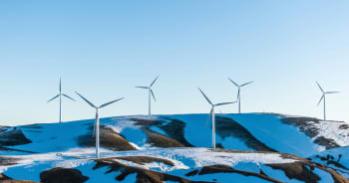
Sensor technologies are being applied in ever more challenging environments but they don’t get much more extreme than a 3800-metre-high volcano in Antarctica.
Sensor technologies are being applied in ever more challenging environments but they don’t get much more extreme than a 3800-metre-high volcano in Antarctica.
The spectroscopic measurements reveal that these bubbles have a very distinct gas composition.
Dr Clive Oppenheimer
Mount Erebus, on Ross Island (from where Scott set out on his doomed journey to the Pole in 1911), is one of the most active volcanoes on Earth, with a more or less permanent lake of lava constantly churning within its summit crater. Lava lakes are particularly simple volcanic systems – in essence, the lake is connected to a larger reservoir of magma by a feeder pipe – and they can remain stable for decades, even centuries. This steady behaviour and geometric simplicity makes them particularly amenable to investigations of the basic processes operating beneath active volcanoes.
The lava lake on Mount Erebus emits a steady stream of hot gases, which forms an acid cloud stretching downwind from the crater. The chemical composition of such effluents provides many clues to what goes on beneath a volcano: how and where molten rock is transported within the Earth’s crust, and why volcanoes erupt in different ways. At Erebus, there is also interest in the extent to which the volcanic ‘pollution’ affects the pristine Antarctic atmosphere – the volcano never switches off, so there is a continuous output of chemically reactive gases into the atmosphere that may, for instance, affect ozone concentrations.
Since 2003, scientists from the volcanology group in Cambridge have been engaged with the US Antarctic Program, tasked with measuring the gas discharge from Erebus. But the challenge is how to make observations of emissions from a 1000 ºC lava lake at the bottom of a 200-metre-deep crater, at an altitude of four kilometres above sea-level in Antarctica, where the ambient temperature is typically minus 35 ºC. Not to mention that the lava lake sporadically explodes showering the upper flanks of the cone with lava bombs!
One attractive solution is the long-established technique of ‘absorption spectroscopy’, in which gas molecules are detected and quantified according to their ability to absorb certain frequencies of light – in this case infrared light. The method has been used in chemistry labs for decades but used to involve bulky equipment unsuited to transport and operation on the side of a volcano. Military requirements to detect potentially harmful gases in battlegrounds led to miniaturisation and ruggedisation of the spectrometers so that they could be mounted on remotely piloted aircraft and flown into the action. These compact instruments have proved very resilient to the rough treatment and immersion in corrosive gas plumes typical of fieldwork on volcanoes. Above all, they enable measurements to be carried out remotely, increasing the safety margin for field scientists. At Erebus, this approach is unearthing some extraordinary secrets of the volcano’s plumbing system, and why it occasionally explodes.
The instrument used on Erebus is about the size of a shoebox. It is attached to a telescope and mounted on a tripod sited right at the edge of the crater, so that it can be tilted to view the lava lake, across a distance of about 300 metres. The incandescent surface of the lake provides abundant infrared light, some of which is absorbed by the volcanic gases before reaching the spectrometer. One important aspect of the technique is the ability to make a measurement every second. This allows detection of the very rapid variations in gas emission that are associated with explosions.
Although most of the time Erebus emits gases calmly from its lava lake, a few times a day, large bubbles of gas – some over 30 metres across – arrive at the surface of the lake where they burst, violently expelling clots of molten lava around and sometimes beyond the crater. The spectroscopic measurements reveal that these bubbles have a very distinct gas composition – especially in respect of the proportions of carbon dioxide and carbon monoxide – compared with the gas released routinely between explosions. This observation suggests that the explosions result from accumulation of gases deep within the volcanic conduit feeding the lava lake, which then travel rapidly to the surface due to their buoyancy. Such insights are extremely valuable in understanding how volcanoes work, and why they can change their behaviour so suddenly.
There are presently two other volcanoes on Earth with long-lived lava lakes. One is in the Great Lakes region of central Africa. The other is Erta ‘Ale, sited within the Danakil Depression of Ethiopia. Here, the environment is as hostile as Antarctica in many ways – through extreme heat rather than cold. Less than 100 kilometres away is the salt mine of Dalol, distinguished for roasting in the highest annual mean temperature ever recorded on Earth – over 34 ºC. The Cambridge volcanologists have used a combination of infrared and ultraviolet sensors to measure both the gas and heat emissions from the lava lake of Erta ‘Ale, revealing that the lake experiences remarkable cycles of activity. These last about 30 minutes and consist of an interlude of rather calm circulation of lava, which is punctuated by vigorous convection that entirely resurfaces the lake with fresh lava within a few minutes.
Comparable cycles have been recognised in the gas and heat observations from Erebus. Such trends suggest that the flow of molten rock into the lava lakes is unsteady, with globs of fresh lava periodically entering the lake and releasing heat and gas. Alternatively, the cycles could result from trains of gas bubbles rising up the feeder pipes. Either way, when volcanoes exhibit cycles they are revealing key aspects of the transport of molten rock and the separation and behaviour of gas bubbles – crucial controls on the nature of volcanic activity.
Thorough analysis of the observations from both Erebus and Erta ‘Ale is in progress and promises fundamental insights into the inner workings of active volcanoes. A better understanding of volcano behaviour contributes directly to forecasting volcanic activity and assessing the hazards that volcanoes pose to society. Although they are among the most remote volcanoes on Earth, these investigations of Erebus and Erta ‘Ale using advanced sensor technologies can make a valuable contribution to understanding volcanoes elsewhere on Earth.
For more information, please contact Dr Clive Oppenheimer, Department of Geography. This research is sponsored by the National Science Foundation Office of Polar Programs and US Antarctic Program.
This work is licensed under a Creative Commons Licence. If you use this content on your site please link back to this page.





